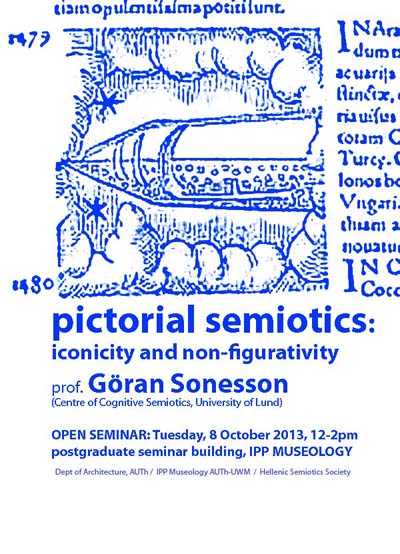Pictorial Semiotics
Tuesday October 8th, 2013 Venue: IPP Museology seminar building Göran Sonesson, prfessor of semiotics, Centre for cognitive semiotics, Lund University The Double Trajectory of Pictorial Semiotics: Iconicity and Non-figurativity Pictorial semiotics involves the study of pictures as particular vehicles of signification. It is that part of the science of signification that is particularly concerned to understand […]
Venue: IPP Museology seminar building
Göran Sonesson, prfessor of semiotics, Centre for cognitive semiotics, Lund University
The Double Trajectory of Pictorial Semiotics: Iconicity and Non-figurativity
Pictorial semiotics involves the study of pictures as particular vehicles of signification. It is that part of the science of signification that is particularly concerned to understand the nature and specificity of such meanings (or vehicles of meaning) that are colloquially identified by the term “picture”. In other words, pictorial semiotics is the study of depiction as a peculiar mode of information and communication. Indeed, although many semioticians have taken an interest in so-called “abstract” or “non-figurative art”, the prototypical concept of picture, which is also prevalent in everyday life, remains that of depiction in the narrow sense: the simulation of the world as it appears to human perception. And yet, the study of “non-figurative” aspects of ordinary pictures has permitted the discovery of another level of organization in the picture sign, the plastic layer. Two accounts could be written about the birth of pictorial semiotics, both taking their point of departure in the middle of the last century. The first story is about the specificity of the picture sign, as compared to other signs, and as related to its sub-types. It involves the Peircean notion of iconicity, less as it has been safeguarded by the true Peirceans, but as it emerges from half a century of criticism, by philosophers such as Bierman and Goodman, as well as semioticians such as Eco and Lindekens; and then rehabilitated, by, among others, Groupe μ, Bouissac, and Sonesson; and it also concerns the Saussurean idea of the way meanings may be organised, again as it was put to confused, and confusing, uses by Eco, Lindekens, and others, then elaborated in the work of Floch, Thürlemann, and other members of the Greimas school, as well as in that of Groupe μ; and finally reconceived in the light of the findings of perceptual and cognitive psychology, in particular by Sonesson. The second story begins with Roland Barthes inventing a simplistic, but still inspiring, model which he applies to a publicity picture; it continues with representatives of the Greimas school, such as Floch and Thürlemann, explaining why this model is inadequate and constructing a new one, with Groupe μ proposing their own, rhetorically-based, model, as well as with the Quebec school insisting on perceptual features, the Australian school taking communicative functions as being fundamental, and the Lund school inventing a second-generation rhetorical model based on Lifeworld expectations and cognitive prototypes.

